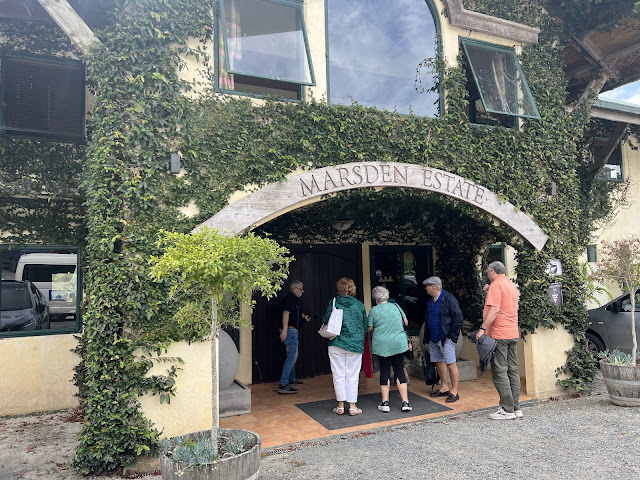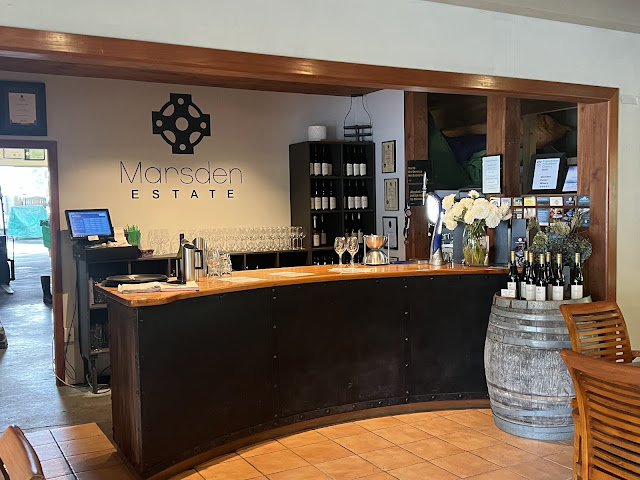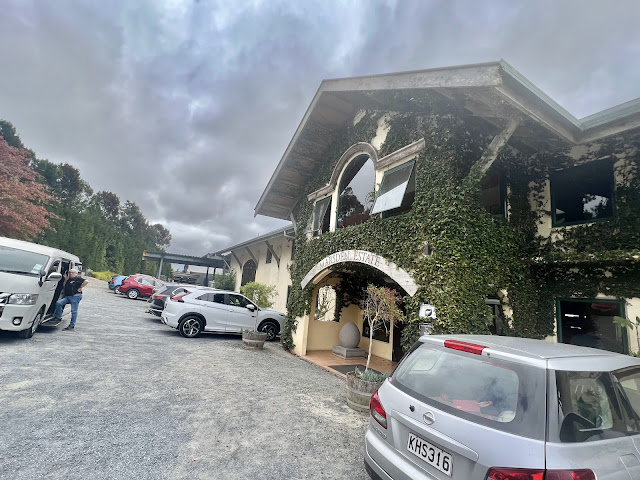No matter where and how I travel wine is always a focus for my explorations. New Zealand was no exception. If you think New Zealand has only Sauvignon Blanc then pay attention. While it is home to some of the world’s best Sauvignon Blancs, it offers much more in terms of wine diversity! It has eleven wine regions, with each region further divided into sub-regions. During our April visit to the North Island on a cruise ship I managed to gain first-hand insights into two of its wine regions, Northland (Bay of Islands), and Auckland (Waiheke Island). Since our stops occurred while on a cruise it required some careful advance planning on my part to maximize our wine country explorations with limited time in port.
Welcome to New Zealand Wine Country
New Zealand has eleven wine regions, with each being divided into sub-regions.
North Island’s main regions: Northland, Auckland, Waitkato, Bay of Plenty, Gisborne, Hawke’s Bay, and Wairarapa (Martinborough).
South Island’s main regions: Marlborough, Nelson, Canterbury/Waipara Valley, and Central Otago.
From its subtropical Northland down to Central Otago (home to the world’s most southerly vineyards), the vineyards of New Zealand extend over 1,100 kilometers (700 miles). The vineyards are mostly found on the eastern coastlines of New Zealand’s North and South Islands. The growing conditions in New Zealand’s vineyards are influenced by its maritime climate. Its vineyards are (1) located no further than 120km (80 miles) from the ocean, and (2) have long sunshine hours and nights cooled by sea breezes.
First, considerable time is needed to explore all of New Zealand's wine regions. Given our travel limitations we were able to briefly visit only two wine regions (Northland, and Auckland) on the North Island. I was about to discover what happens when you fit New Zealand wine country into sea travel plans. What follows are a few wine country insights from cruising the New Zealand Coast.
Our first New Zealand wine country travels was in Northland (NI), which has a sub-tropical climate. Northland wineries can be found in areas, such as Mangawhai, Whangarei, Bay of Islands, and Kerikeri. All these areas provide opportunities to enjoy wine. Given our schedule we were only able to visit the Bay of Islands where we chose to do a wine tour.
Northland is not only the oldest, but is also the warmest wine growing region in New Zealand. Warm spring temperatures, hot dry summers, and calm, clear autumn days mean fruit ripens early, creating full-bodied, rich and generous wine. It is home to a wide range of grape varieties, with the main grape varieties being Chardonnay, Pinot Gris, and Syrah, and many more are successfully grown. Two-hundred years after Samuel Marsden planted New Zealand’s first grapevines, Northland winegrowers are still searching for the perfect combination of soil, grape variety, and climate. From Karikari in the north, to Mangawhai in the south, each Northland vineyard is considered unique in terms of soil, and micro-climate.
1. Bay of Islands Wine Region
The Bay of Islands is a tender port, so we arrived by water shuttle at the Waitangi Wharf. Upon arrival in Waitangi given we had pre-booked a wine tour we were met and directed to their transport. The Bay of Islands Wine Tour took us to Marsden Estate and Sovrano Estate for wine tasting, and Phat House Brewery for a craft beer tasting. Wine country landscape in the land of hobbit, even in the fall got our attention.
Marsden Estate
Marsden Estate, our very first stop in the Bay of Islands was the perfect intro to this wine region.
Marsden Estate © Spaswinefood
Upon arrival we were seated, served a charcuterie platter, and introduced to six of their wines.
Marsden Estate, Pinot Gris, Bay of Islands 2022
Marsden Estate, Pinot Gris, Bay of Islands 2022 © Spaswinefood
Marsden Estate, Chambourcin, Bay of Islands 2021 © Spaswinefood
We so enjoyed our very first tasting in New Zealand at Marsden Estate.
Marsden Estate, Bay of Islands © Spaswinefood
Because we were visiting New Zealand in their Fall season it meant that the 2024 harvest had already been completed.
We saw fall time foliage on the vines amid the land of hobbit landscape.
Sovrano Estate
When we arrived at Sovrano Estate it was quite busy with a large group. We did however, get to taste their wines.
Sovrano Estate © Spaswinefood
Amongst the wines we tasted were a Sauvignon Blanc Vermintino blend, an organic red wine blend, and a Reserve Chambroucin.Sovrano Estate, Sauvignon Blanc Fermentino 2022
Sovrano Estate, Reserve Charbourcin 2021
Sovrano Estate, Reserve Charbourcin 2021 © Spaswinefood
This was the second Bay of Island's Charbourcin that we tasted. Chambourcin is a very productive grape with high crop yields, which has good resistance to fungal diseases. This was not my first encounter with this grape given it is widely planted in parts of the US and Canada. Hence it is not surprising to find it planted in New Zealand's Northland Region, New South Wales’s Hunter Valley Region, and other warm, humid regions in Australia; also in France and Portugal. This French-American hybrid grape variety, has been available since 1963. The hybrid was produced by Joannes Seyve who used Seibel hybrids created in the 1860s.
On my way out I did manage to take a quick look at the fall foliage at Sorano Estate.
Fall Colors, Sovrano Estate Vineyard © Spaswinefood
Obviously, the timing of our visit meant it was a great time to observe the fall foliage at both wineries.
Phat House Brewery
Our final stop, Phat House Brewery offered us a paddle of craft beer to taste. We each selected four beers to taste.
Beer Tasting, Phat House Brewery © Spaswinefood
Here's to Beer Tasting, Phat House Brewery © Spaswinefood
Learning about the brewery, and selecting four of their craft beers to taste, was a fun finale.
After visiting two wineries and one brewery it was time to head back to the ship. The Waitangi Wharf Bay of Islands Yacht Club facilities are open to cruise visitors. The club provides restroom facilities, a small cafe offering homemade wares, hot and cold drinks, and offers spectacular views of your ship anchored in the Bay. Unfortunately, we did not have enough time to visit the yacht club. We did however, enjoy our introduction to Bay of Islands Wine Country. In terms of wine insights I left obviously with many questions and ideas to explore later.
2. Auckland Wine Region
Our second stop in New Zealand was Auckland. Auckland, one of New Zealand's oldest wine regions, was established in the early 1900s by passionate Croatian, Lebanese and English winemakers. Auckland’s wine region, is spread across a large, geographically diverse area. It has three distinctive subregions, Waiheke Island, historic West Auckland, and stretches north to the coastal enclave of Matakana. This region is home to powerful, intense reds. Red blends in the north and on Waiheke Island (which also has great Syrah), plus world class Chardonnay and fine Aromatics. The result is Auckland’s modern wine industry, with its Red Blend (Bordeaux style), Merlot, Syrah and Chardonnay, stands out. I was excited by the fact that some of the most famous wineries in the North Island are found on Waiheke Island.
While in Auckland we took the ferry to Waiheke Island to visit wineries. In fact, we were so excited to be able to catch the ferry to Waiheke Island. We loved cruising through the Hauraki Gulf to the island. After disembarking it was onto a hop-on, hop-off double-decker bus tour of this enchanting island.
Waiheke Island
This picturesque island further defines the boundaries of the Auckland wine region. While the island is within the boundaries of the Auckland region it has a unique terroir. Its warm, dry maritime climate promotes intensity, varietal depth, and purity of fruit. It is known for its Cabernet blends, the island has been applauded for its gutsy Syrah, elegant Chardonnay, deep, fruit-filled Montepulciano and Petit Verdot, and fragrant Viognier and Pinot Gris wines. We would get to taste some of these.
Taking the ferry to visit Waiheke Island wineries meant we cruised through the Hauraki Gulf. As we left port that cloudy April morning I enjoying viewing Auckland in the distance.
Off to Waiheke Island, Auckland Wine Country © Spaswinefood
After disembarking it was onto a hop-on, hop-off double-decker Explorer Bus tour of this enchanting island. Visitors soon discover the island’s iconic spots like Oneroa Village, and Onetangi Beach. By hopping on and off at leisure we explored some of its vineyards. Moreover, if time permits visitors can also discover its beaches, restaurants, and more.
While on Waiheke Island we planned to checkout the wines at Stonyridge Vineyard, Te Motu Vineyard,Tantalus Estate, and Mudbrick Vineyard. Given our time restrictions, and some closures that day we managed to do a wine tasting at Stonyridge, and have lunch with wines at Mudbrick. It was an amazing day with good wines, and a fabulous lunch at Mudbrick Winery.
Stonyridge Vineyard
Our first stop on the island was Stonyridge Vineyard.
As we exited the bus on the main route we walked up the hill towards the Vineyard. The estate is situated on gently rolling hills. Once we reached the entrance we headed to a veranda cafe where we selected a wine tasting option from the menu. We elected to do their premium wine tasting. This tasting ended up being their La Bodega Pinot Gris 2023, Airfield 2022 - their flagship wine, and Larosse 2021- their well known Bordeaux style blend.
This was our first introduction to Waiheke Island wines. We were not disappointed, as it lived up to its reputation for excelling in its Bordeaux style blends.
Next, after later finding out that two of our planned wine stops were closed we headed back across the island to Mudbrick Vineyard.
Mudbrick Vineyard just happens to be one of the best wineries on the island, with some of the best views. Given this winery has an excellent restaurant we decided to have lunch and order some of their premium wines to taste.
Rather than do a standard wine tasting we elected to order two of their Reserve Chardonnays (2022 and 2023), and their Reserve Syrah 2020.
Budbrick, Reserve Chardonnay 2023 (left) & 2022 (right)
Reserve Chardonnays 2023 (left) and 2022(Right) © Spaswinefood
Reserve Chardonnay 2023 © Spaswinefood
These are excellent Chardonnays.
Mudbrick, Reserve Syrah 2020 (left) Reserve Chardonnay 2022 (right)
Mudbrick Vineyard, Reserve Syrah 2020 (left) Reserve Chardonnay 2022 (right) © Spaswinefood
We were impressed by the wine quality here. It certainly illustrated gutsy Syrah, and elegant Chardonnay for which the island is known for producing. So glad we came because we were not disappointed. Indeed, I can see why this winery is so popular and gets top reviews. Moreover, we absolutely enjoyed the stunning views from this winery.
Later, we would head back to the ferry terminal to take the ferry back to Auckland. I was so glad that we visited Waiheke Island given that some of the most famous wineries in the North Island are found there.
After leaving port at Auckland it was onto Tauranga for our third and final stop in New Zealand. Tauranga’s Mount Maunganui is an idyllic beach and popular holiday spot.
Tauranga, New Zealand © Spaswinefood
Cruise ships docking in Tauranga offer many tour options, and optional day trips to Rotorua, which is approximately one hours drive from the Port of Tauranga. In geothermal Rotorua, boiling mud pools, geysers and natural hot springs offer unique experiences for those seeking such adventures. Tauranga and Rotorua are both rich in Māori history. Our Tauranga stop was a nice change of pace, to round out our New Zealand wine travel explorations.
Considerable time is needed to explore New Zealand's wine regions. Given our limited time on land in New Zealand we were able to briefly visit only two wine regions (Northland, and Auckland) on the North Island. For sure my intro to the North Island's wine country while cruising the New Zealand's coast has inspired me to learn more, and enhanced my desire for future wine travels in the South Island. I invite you to join me in my travels in New Zealand and elsewhere at Wine Travels with Dr. Sharon, and at Spaswinefood on Twitter and Facebook. I look forward to sharing more on my vine-filled explorations in New Zealand.
CHEERS!
Sharon
April 2024
North Island Wine County, New Zealand
© Spaswinefood




































No comments:
Post a Comment